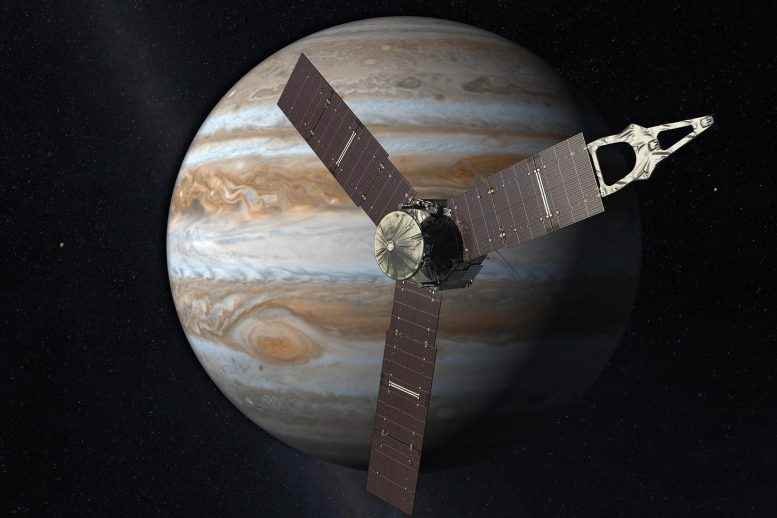Bir sanatçının Jüpiter’in yörüngesindeki Juno uzay aracı konsepti. Kredi bilgileri: NASA
Juno uzay aracı, Europa’ya yakın bir yaklaşımla yaklaşırken, değerli bilim ve olağanüstü görüntüler sağlaması bekleniyor.[{” attribute=””>NASA’s upcoming Europa Clipper mission.
In less than three days, on Thursday, September 29, at 2:36 a.m. PDT (5:36 a.m. EDT), NASA’s Juno spacecraft will come within 222 miles (358 kilometers) of the surface of Jupiter’s ice-covered moon, Europa. During the close flyby, the solar-powered spacecraft is expected to obtain some of the highest-resolution images ever taken of portions of Europa’s surface. It will also collect valuable data on the moon’s interior, surface composition, and ionosphere, along with its interaction with Jupiter’s magnetosphere.
Future missions could benefit greatly from this detailed information. One such mission is Europa Clipper, which is set to launch in 2024 to study the icy moon. “Europa is such an intriguing Jovian moon, it is the focus of its own future NASA mission,” said Juno Principal Investigator Scott Bolton of the Southwest Research Institute in San Antonio. “We’re happy to provide data that may help the Europa Clipper team with mission planning, as well as provide new scientific insights into this icy world.”

This image of Jupiter’s moon Europa was taken by the JunoCam imager aboard NASA’s Juno spacecraft on Oct. 16, 2021, from a distance of about 51,000 miles (82,000 kilometers). Credit: Image data: NASA/JPL-Caltech/SwRI/MSSS, Image processing: Andrea Luck CC BY
Europa is about 90% the size of Earth’s Moon, with an equatorial diameter of 1,940 miles (3,100 kilometers). Researchers believe a salty ocean lies below a miles-thick ice shell, sparking questions about potential conditions capable of supporting life underneath Europa’s surface.
Gravitational forces from the close flyby will modify Juno’s trajectory, reducing the time it takes to orbit Jupiter from 43 to 38 days. It will be the closest a NASA spacecraft has approached Europa in over 22 years, since Galileo came within 218 miles (351 kilometers) on January 3, 2000. Additionally, this flyby marks the second encounter with a Galilean moon during Juno’s extended mission. In June 2021, the mission explored Ganymede and plans include making close approaches of Io in 2023 and 2024.
Data collection on the spacecraft will begin an hour prior to closest approach, when the Juno is 51,820 miles (83,397 kilometers) from Europa.
“The relative velocity between spacecraft and moon will be 14.7 miles per second (23.6 kilometers per second), so we are screaming by pretty fast,” said John Bordi, Juno deputy mission manager at JPL. “All steps have to go like clockwork to successfully acquire our planned data, because soon after the flyby is complete, the spacecraft needs to be reoriented for our upcoming close approach of Jupiter, which happens only 7 ½ hours later.”

Juno’s extended mission includes flybys of the moons Ganymede, Europa, and Io. This graphic depicts the spacecraft’s orbits of Jupiter – labeled “PJ” for perijove, or point of closest approach to the planet – from its prime mission in gray to the 42 orbits of its extended mission in shades of blue and purple. Credit: NASA/JPL-Caltech/SwRI
Juno’s full suite of instruments and sensors will be activated for the Europa encounter. The spacecraft’s Jupiter Energetic-Particle Detector Instrument (JEDI) and its medium-gain (X-band) radio antenna will collect data on Europa’s ionosphere. Its Waves, Jovian Auroral Distributions Experiment (JADE), and Magnetometer (MAG) experiments will measure plasma in the moon’s wake as Juno explores Europa’s interaction with Jupiter’s magnetosphere.
MAG and Waves will also search for possible water plumes above Europa’s surface. “We have the right equipment to do the job, but to capture a plume will require a lot of luck,” said Bolton. “We have to be at the right place at just the right time, but if we are so fortunate, it’s a home run for sure.”
Inside and Out
Juno’s Microwave Radiometer (MWR) will gaze into Europa’s water-ice crust to obtain data on its composition and temperature. This is the first time that data like this will be gathered to study the moon’s icy shell.
Additionally, during the flyby the mission expects to take four visible-light images of the moon with JunoCam (a public-engagement camera). The Juno science team will compare them to images from previous missions, so they can find any changes in Europa’s surface features that might have occurred over the past two decades. These visible-light images will have an expected resolution of better than 0.6 miles (1 kilometer) per pixel.
Bu film, 29 Ekim 2018’de Juno’nun 16. perijove’si (bir yörüngenin Jüpiter’in merkezine en yakın olduğu nokta) sırasında toplanan görüntüler kullanılarak oluşturuldu. Vatandaş bilim adamları Gerald Eichstädt, bu filmi uzay aracının JunoCam görüntüleyicisinden gelen verileri kullanarak oluşturdu. Kredi: NASA/JPL-Caltech/SwRI/MSSS’nin izniyle sağlanan görüntülere dayalı Gerald Eichstädt tarafından geliştirilmiş görüntü
Juno, aya en yakın olduğu zaman Europa’nın gölgesinde olacak. Bununla birlikte, Jüpiter’in atmosferi, Juno’nun görünür ışık görüntüleyicilerinin veri toplaması için yeterli güneş ışığını yansıtacaktır. Görevin yıldız kamerası ( Yıldız Referans Birimi) Europa’nın yüzeyinin yüksek çözünürlüklü siyah beyaz bir görüntüsünü alacaktır. Juno’nun yönünü bulmasına yardımcı olmak için yıldız alanlarının fotoğraflarını çekmek ve bilinen konumlara sahip parlak yıldızları aramak için tasarlandı. Bu arada, Jovian Infrared Auroral Mapper (JIRAM), yüzeyinin kızılötesi görüntülerini yakalamaya çalışacak.
Juno’nun yakın çekim görüntüleri ve MWR cihazından alınan veriler, 2030’da Europa’ya vardıktan sonra buzlu ayın yaklaşık 50 uçuşunu gerçekleştirecek olan Europa Clipper misyonunu bilgilendirecek. Europa Clipper, ayın atmosferi, yüzeyi ve iç kısmı hakkında veri toplayacak. Bu bilgi ile bilim adamları, Europa’nın küresel yer altı okyanusunu, buz kabuğunun kalınlığını ve yer altı suyunu uzaya bırakabilecek olası tüyleri daha iyi anlamayı umuyorlar.
Misyon Hakkında Daha Fazla Bilgi
Caltech’in Pasadena, California’daki bir bölümü olan NASA’nın Jet Propulsion Laboratory (JPL), San Antonio’daki Güneybatı Araştırma Enstitüsü’nden baş araştırmacı Scott J. Bolton için Juno misyonunu yönetiyor. Juno, ajansın Washington’daki Bilim Misyonu Müdürlüğü için NASA’nın Huntsville, Alabama’daki Marshall Uzay Uçuş Merkezinde yönetilen NASA’nın Yeni Sınırlar Programının bir parçasıdır. Denver’daki Lockheed Martin Space, uzay aracını inşa etti ve işletti.

